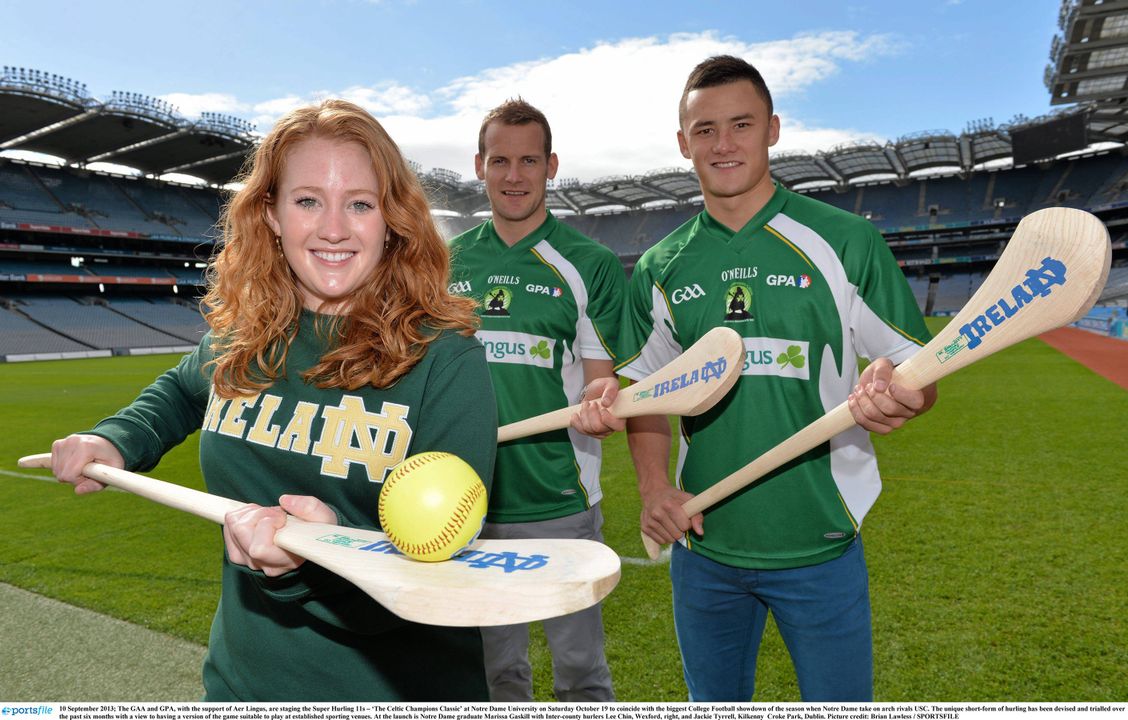Sept. 23, 2013
NOTRE DAME, Ind. – Irish hurling is headed for the University of Notre Dame.
The Gaelic Athletic Association and the Gaelic Players Association, with the support of Aer Lingus, will stage the Super Hurling 11s “The Celtic Champions Classic” at 3:30 p.m. EDT, on Saturday, Oct. 19, at Arlotta Stadium (the Irish lacrosse facility) on the Notre Dame campus.
Admission is free. The hurling event will be played just a few hours prior to the Notre Dame-USC football game that will kick off at 7:30 p.m. EDT at Notre Dame Stadium.
“We’re honored to host the game and the great champion Dónal Óg Cusack, who once described hurling as `our song and our verse…'” said Paul J. Browne, vice president for public affairs and communications at Notre Dame.
“The public shouldn’t miss this opportunity. Come join the chorus and witness what the Celts invented played at its highest level by fiercely talented lads on a field that they should consider their home away from home.”
The unique short-form version of hurling has been devised and trialed over the past six months with a view to having a version of the game suitable to play at established sporting venues. Hurling normally features 15 players per side.
The adjusted-rules event will feature two all-star teams, including some of the best of Ireland’s hurling stars from their county teams.
Ireland county squads from Cork and Clare will play for the All-Ireland Senior Hurling Championship Sept. 28 at Croke Park in Dublin, Ireland, in a replay — after the two teams played to a draw in their initial championship meeting Sept. 8. Kilkenny has been the most dominant county in recent years, winning nine All-Ireland titles from 2000 through 2012.
Uachtarán Chumann Lúthchleas Gael Liam Ó Néill said: “We are delighted to announce details of this joint initiative with the GPA, one that presents us with an unrivalled opportunity to showcase the special game that we all know hurling is to a new audience. I look forward to seeing how the game is received and also how our players adapt to it.”
GPA chairman Dónal Óg Cusack added: “This classic exhibition is a truly wonderful opportunity for us to exhibit hurling at a high profile United States sporting event. We believe that our games rank alongside the best sports in the world and the staging of this game in Notre Dame is part of our commitment to convey that message to a new and influential audience.”
Declan Kearney, Aer Lingus director of communications said: “This is an excellent opportunity for hurling to further boost its rapidly growing international appeal. We’re delighted to lend our support to the GAA and GPA in the initiative and are looking forward to welcoming Ireland’s greatest hurlers onboard in October.”
The Super 11s, which was displayed as part of the Aer Lingus/Etihad Airways International Hurling Festival in Galway, Ireland, last weekend, also will form part of the game day for the All-Ireland Senior Hurling Final replay between Clare and Cork Saturday in Croke Park.
The GPA supports more than 2,000 elite amateur Gaelic footballers and hurlers in Ireland by providing a comprehensive development plan for players. Since 2011 the GPA has worked through a New York advisory board to help develop a network of supporters for the work of the players’ body and to promote Gaelic games to a wider American audience.
Hurling is believed to be the world’s oldest field game. When the Celts came to Ireland as the last ice age was receding, they brought with them a unique culture, their own language, music, script and unique pastimes. One of these pastimes was a game now called hurling. It features in Irish folklore to illustrate the deeds of heroic mystical figures and it is chronicled as a distinct Irish pastime for at least 2,000 years.
The stick, or “hurley” (called camán in Irish) is curved outwards at the end, to provide the striking surface. The ball or “sliotar” is similar in size to a hockey ball but has raised ridges.
Hurling is played on a pitch that can be up to 145m long and 90m long. The goalposts are similar to those used on a rugby pitch, with the crossbar lower than in rugby and slightly higher than a soccer one.
You may strike the ball on the ground, or in the air. Unlike hockey, you may pick up the ball with your hurley and carry it for not more than four steps in the hand. After those steps you may bounce the ball on the hurley and back to the hand, but you are forbidden to catch the ball more than twice. To get around this, one of the skills is running with the ball balanced on the hurley To score, you put the ball over the crossbar with the hurley or under the crossbar and into the net by the hurley for a goal, the latter being the equivalent of three points.
Each team is made up of 15 players with match officials and scoring values the same as in Gaelic football.
— ND —







